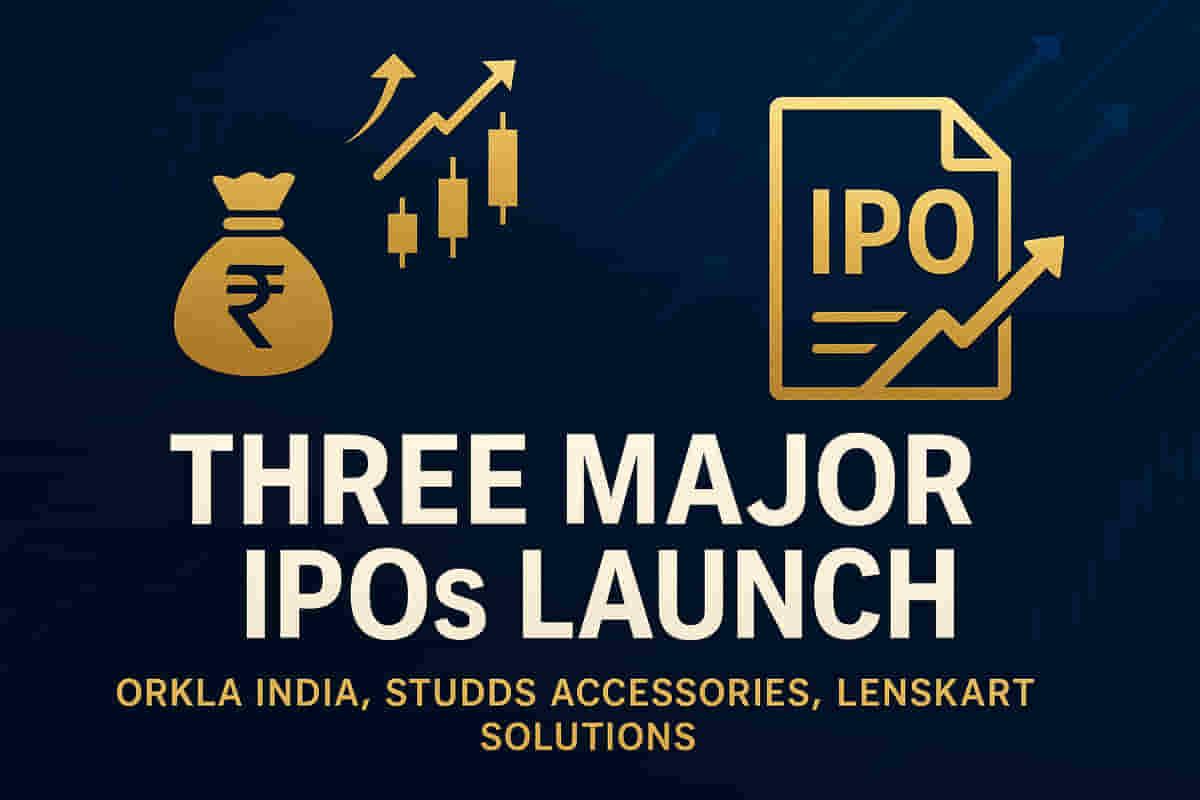Three Major IPOs Launch: Orkla India, Studds Accessories, and Lenskart Solutions Aim to Raise Over ₹9,400 Crore
IPO
|
30th October 2025, 5:47 AM

▶
Short Description :
Detailed Coverage :
The Indian primary market is experiencing a surge in activity with three significant Initial Public Offerings (IPOs) from Orkla India, Studds Accessories, and Lenskart Solutions opening this week, collectively aiming to raise over ₹9,400 crore. Orkla India plans to raise ₹1,667.5 crore, Studds Accessories ₹455.5 crore, and Lenskart Solutions ₹7,278 crore. Orkla India's IPO opened on October 29 and closes on October 31. Studds Accessories' IPO began October 30 and ends November 3, while Lenskart Solutions launches on October 31. Grey market premiums indicate strong investor interest, especially for Lenskart. Analysts generally recommend subscribing to these IPOs for long-term growth, citing solid fundamentals and sector tailwinds, though Lenskart's valuations are noted as steep with limited potential for immediate listing gains. Orkla India is recognized as a stable FMCG company, Studds Accessories as India's leading helmet maker with a debt-free balance sheet, and Lenskart as a fast-growing eyewear retailer.
**Impact** This activity boosts the primary market, signaling investor confidence and offering opportunities in growing businesses. The reception of these IPOs will also indicate overall market sentiment towards new listings. **Impact Rating**: 7/10
**Difficult Terms**: * **Mainboard IPO**: An Initial Public Offering (IPO) made by a company seeking to list its shares on the main trading platform of a stock exchange, typically for well-established companies. * **Primary market**: The market where new securities are issued and sold for the first time, such as during an IPO. * **Subscription**: The process where investors apply to buy shares in an IPO. * **Public issues**: Refers to an IPO or any other offering of securities to the general public. * **Offer documents**: Formal legal documents filed with regulatory authorities and provided to potential investors, detailing the terms of an IPO. * **Bidding**: The process of investors indicating the price and quantity of shares they wish to buy in an IPO. * **Equity shares**: The most common type of stock, representing ownership in a company. * **Grey market premium (GMP)**: The unofficial premium at which shares of an IPO are traded in the grey market before they are listed on the stock exchange. * **Unlisted shares**: Shares of a company that are not yet traded on a public stock exchange. * **Price band**: The range within which the IPO shares will be offered to investors. * **Listing-day performance**: How the stock price performs on the first day of trading on the stock exchange after an IPO. * **Street View**: The general opinion or sentiment of market analysts and investors regarding a stock or IPO. * **Solid fundamentals**: The underlying financial health and business strength of a company. * **Sector tailwinds**: Favorable trends within the industry sector that benefit a company. * **Growth potential**: The expected future increase in a company's revenue, profits, or market share. * **Valuations**: The assessment of a company's worth, often expressed as ratios like P/E or EV/Sales. * **FMCG (Fast-Moving Consumer Goods)**: Products that are sold quickly and at relatively low cost, such as packaged foods, toiletries, and beverages. * **Fiscal year (FY25)**: The financial year from April 1, 2024, to March 31, 2025. * **Net profit**: The profit remaining after all expenses, taxes, and interest have been deducted. * **Revenue**: The total income generated from the sale of goods or services. * **P/E (Price-to-Earnings ratio)**: A valuation metric that compares a company's share price to its earnings per share. * **Brand equity**: The commercial value derived from consumer perception of the brand name of a particular product or service. * **Diversified portfolio**: A range of different products or services offered by a company. * **Resilient margins**: The ability of a company to maintain its profit margins even during challenging economic conditions. * **Brokerage**: A firm that buys and sells securities on behalf of clients, or provides investment advice. * **CAGR (Compounded Annual Growth Rate)**: The mean annual growth rate of an investment over a specified period of time longer than one year. * **Strategically positioned**: Located or organized in a way that is advantageous for achieving success. * **Debt-free balance sheet**: A company that has no outstanding loans or financial obligations. * **Premiumisation**: The strategy of marketing products or services at a higher price point, often associated with enhanced quality or features. * **Manufacturing**: The process of making goods from raw materials. * **Integrated operations**: Combining different stages of production or services into a single entity. * **International footprint**: The extent of a company's operations and presence in foreign countries. * **Steep valuations**: When a stock's price is considered high relative to its earnings or fundamental value. * **EV/Sales (Enterprise Value to Sales)**: A valuation ratio comparing a company's total value (market cap + debt - cash) to its total revenue. * **EV/Ebitda (Enterprise Value to Earnings Before Interest, Taxes, Depreciation, and Amortization)**: A valuation ratio that compares a company's total value to its earnings before interest, taxes, depreciation, and amortization. * **Post-issue capital**: The total capital of the company after the new shares issued in an IPO have been added. * **Listing gain**: The profit an investor makes if the IPO stock's price increases on its first day of trading. * **Ebitda margins**: A profitability ratio that shows how much profit a company makes from its core operations relative to its revenue. * **Turnaround to profitability**: When a company that was previously making losses starts generating profits. * **PAT (Profit After Tax)**: The profit a company has left after all expenses and taxes have been paid.